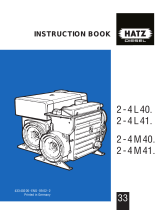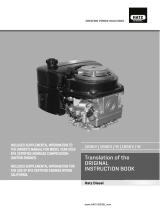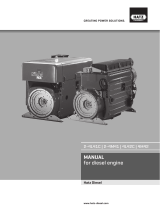Important!
If a starter protection module is installed, the
start key has to be returned to position 0 for at
least 8 seconds after the engine has failed to
start or after switching it off before a further
attempt can be made to start the engine.
Preheating device with automatic heating
timer (additional equipment)
The preheating light „6“ lights up additionally at
temperatures below 0° Celsius (Fig. 15).
– After the light has gone out, start the engine
without delay.
Automatic shut-down function
(additional equipment)
This is characterized by a brief flashing of all
pilot lamps once the starter key has been turned
to position I, figure 15.
Important!
If the engine cuts out immediately after starting
or switches off by itself during operation, a
monitoring element in the automatic shutdown
system has tripped. The corresponding indicator
light (Fig. 15, positions 2 - 5) will come on.
After the engine has stopped, the display contin-
ues to glow for about 2 minutes.
The electrical device then switches itself off au-
tomatically. The display lights up again after the
start key has been turned back to position 0 and
then to position I again.
Trace and eliminate the cause of the operating
fault before trying to restart the engine (see
chapter 7).
The display light goes out when the engine is
next started.
Even with automatic shutdown monitoring the
oil level must be checked every 8 – 15 operat-
ing hours (Chapter 5.2.1.).
On 4L42C and 4M42 engines only
16
These engines are equipped with an exhaust gas
recirculation valve (EGR). This results in the fol-
lowing changes regarding the pilot lamps:
– The engine diagnosis indicator „4“ goes on as
soon as the cylinder head temperature exceeds
the admissible range.
Stop the engine and eliminate the cause as
described in Chapter 7.
– The pilot lamp „5“ flashes during operation
only if there is a problem in conjunction with
the exhaust gas recirculation system. This also
includes a contaminated air cleaner. This is in-
dicated by the following flashing code of pilot
lamp „5“:
7 short flashes (approx. 0.5 seconds) and
1 long flash (approx. 1.5 seconds)
The flashing code indicates that the air cleaner
must be cleaned or replaced, chapter 5.4.2.
For troubleshooting regarding other flashing
codes, please contact immediately your nearest
HATZ service station.
Problems in the exhaust gas recirculation
system may impair the engine’s exhaust gas
values.
16





























